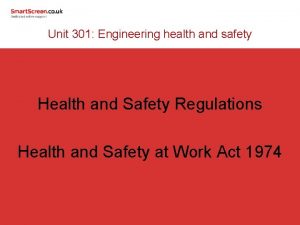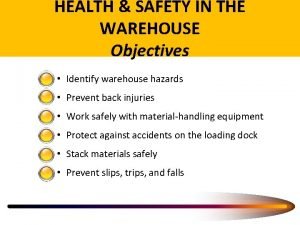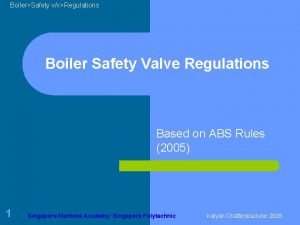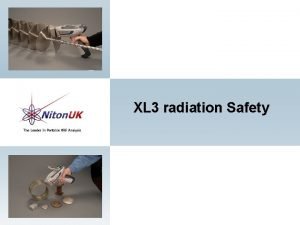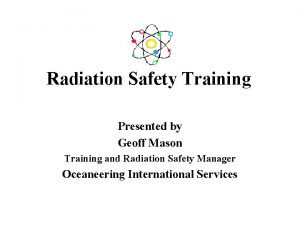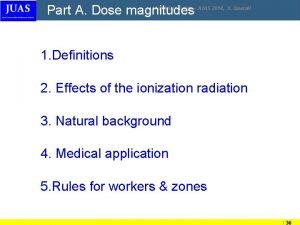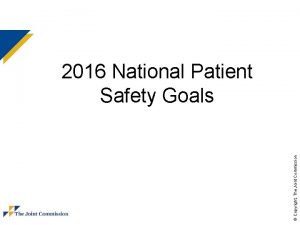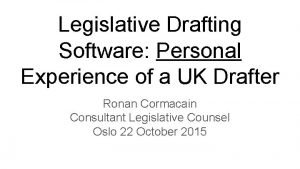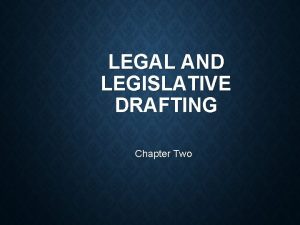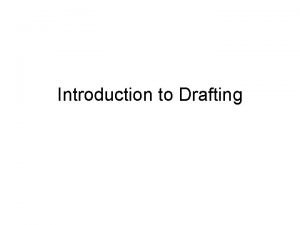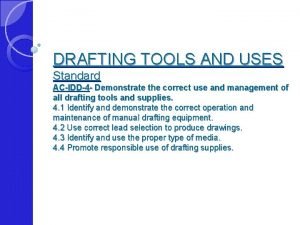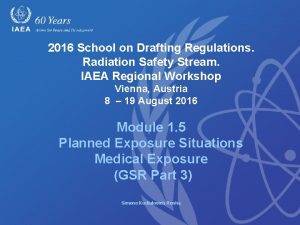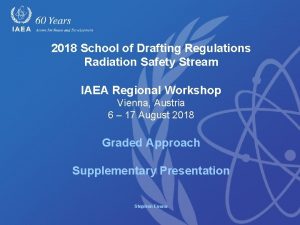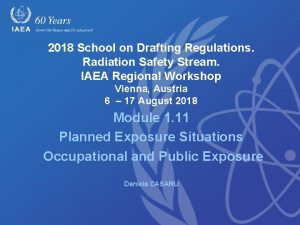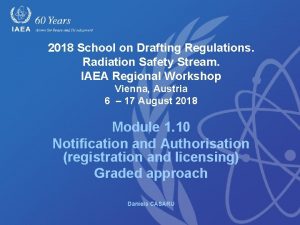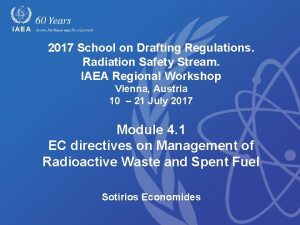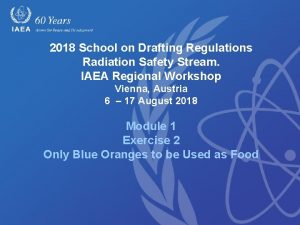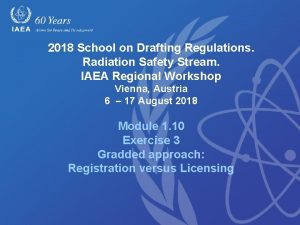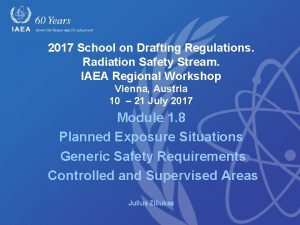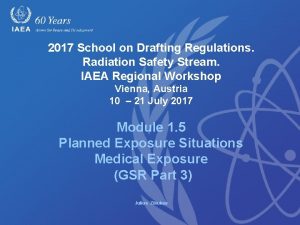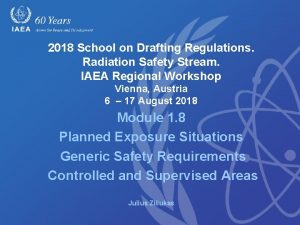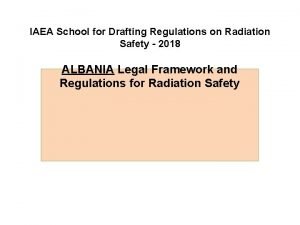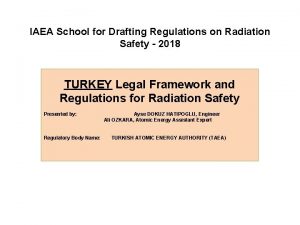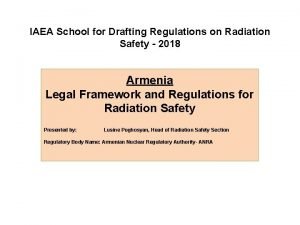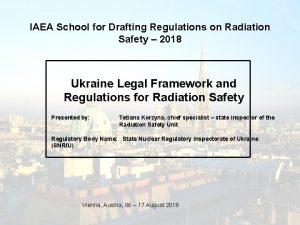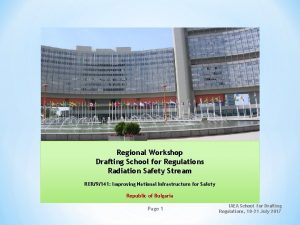2016 School on Drafting Regulations Radiation Safety Stream
































- Slides: 32

2016 School on Drafting Regulations. Radiation Safety Stream. IAEA Regional Workshop Vienna, Austria –January 2017 Module 1. 6 Regulatory approach Simone Kodlulovich Renha

Contents • • • Introduction Development of an effective regulatory framework Regulatory programme Regulations Hierarchical structure Regulatory approach / national framework Regulatory approach: Characteristics Regulatory approach Regulatory concepts: Graded approach Regulatory concepts: Exemption Regulatory concepts: clearance Regulatory concepts: Optimization

Introduction • Expressive changes have been observed in the regulatory framework of many countries: – Independent RB have been established – internationally recommendations and best practices have been incorporating • However, there are countries that it is not established yet

Development of an effective regulatory framework 1. Requires: a comprehensive set of laws, rules, and regulations that clearly identifies the contractual obligations and property rights of governments and stakeholders. 2. Structure: determined, in part, by the legal and constitutional system of each country 3. Conception: of law and legal system varies from country-to country – is often rooted in perceptions based on customs, culture, religion, political and economic influences

Regulatory programme • Regulations: requirements and standards for protection and safety, and related administrative requirements; • System of notification and authorization (registration or licensing): for control over possession and use of radiation sources; • Exclusions and granting exemptions: provisions should be established; • Compliance monitoring, including inspection: to assess the status of safety and compliance with regulatory requirements; • Enforcement: to compel compliance with regulatory requirements; • Investigation of accidents: and management of emergencies; • Dissemination of information: on protection and safety.

REGULATIONS: (TECDOC 1067) Principal purpose: to codify radiation safety requirements of general applicability. By providing orderly procedures and clear statements of requirements, regulations serve to stabilize the regulatory process. Regulations should define: – Administrative requirements: for notification, authorization by registration or licensing – Requirements for: protection and safety of workers and members of the public and patients (when appropriate).

Hierarchical structure Principal requirements Legislation Detailed requirements Regulations Practice specific requirements or guidance Codes of practice

Hierarchical structure A national legal system should include, as appropriate • • • statutes or laws decrees regulations, ordinances decisions codes of practice safety guides, standards, etc. 8

Hierarchical structure • Acts/Laws: strong authority (courts), difficult to amend quickly. They should empower regulatory authority and establish fundamental principles and concepts. • Regulations: strong authority (regulatory penalties) but can usually be amended relatively quickly. • Guidance: weak authority but can be adapted very quickly. 9

Codes of Practice Typically developed for specific practices, such as: • • industrial radiography diagnostic radiology research use of radionuclides fixed and portable gauges • Usually developed and issued by the RB or expert body • Give practice-specific advice on how to achieve regulatory requirements • are not necessarily legally binding – unless linked to authorization 10

Hierarchical structure 11

Regulatory approach / national framework • Regulations and guides approach chosen so as to suit national framework: – The legal system of the State – The nature and extent of the facilities and activities to be regulated. – The national regulatory philosophy: balance between flexibility and the need for detailed requirements – The availability of adequate financial and other resources for RB – The availability of the experience and competence of RB 12

Regulatory approach • The system of regulations adopted should provide an appropriate balance between regulatory provisions that are: – numerous and detailed enough to achieve and maintain safety, and – flexible enough to permit their application to developing technologies and in new circumstances 1. 6 Regulatory Approach 13

Regulatory approach: Characteristics – Number of regulations and guides – Resources – Competence – Flexibility – Public credibility – Authorised parties expectations 1. 6 Regulatory Approach 14

IAEA Safety Standards: Technical Support

Regulation development Types: • Performance-based regulations: flexible, easy to adopt the regulations to evolving circumstances and technology. • Prescriptive regulations: detailed requirements for ease in determining when the requirements are being met.

Regulatory approach Performance-based regulations what must be achieved? set out overall radiation safety requirement and basic operational parameters Prescriptive regulations how to achieve radiation safety set out detailed requirements Most regulations contain both regulations types, but often characterized predominantly as performance orientated or prescriptive orientated

Regulatory approach Performance-based Requirements The type and frequency of the workplace monitoring shall be sufficient to enable evaluation of the radiological conditions, assessment of exposures, review of the classification of the areas. Prescriptive Requirements Workplace monitoring shall include permanent dose rate measurement, activity concentration in the air measurements once per hour and daily surface contamination measurements using the method of wipe tests. Wipe tests of bench and sink areas should be conducted over an area of 100 cm 2. 1. 6 Regulatory Approach 18

Performance orientated regulations Advantage Relatively easier to be developed and maintained. Focus on what is to be achieved in terms of protection and safety Applicable to a range of practices. If well drafted, do not need to be updated frequently with technology changing (more stable) Bring flexibility – can be adapted to evolving circumstances Request licensee to discharge effectively its prime responsibility for safety Specify primarily the overall safety objectives Disadvantaged Need to judge how the operator has interpreted regulations in each specific situation before assessing whether the regulations has been fulfilled Need expertise, detailed knowledge and resources to review, assess and inspect the arrangements of the licensee Need guides to facilitate a common understanding, acceptable ways of meeting performance based regulations Need to be interpreted in relation to each different practice. room for misunderstanding This places a significant burden on the time, skills and requires higher level of expertise of the RB and the users May need prescriptive requirements if safety objectives are not met

Prescriptive regulations: largely practice-specific Advantage Provide to the RB and the user requirements clearly defined for a particular practice. easy to determine when requirements are met Prescribe what to do to comply with the requirements and how to achieve an adequate level of protection and safety. Applicant knows what will be acceptable for the RB. Easy for licensee to comply Sets clear expectations and detailed requirements for a particular activity or situation, including means and methods Reduce time and skills to conduct a licensing review or an inspection. Focus the authorization and inspection process on simple verification of compliance Clarifies the relations between the RB and the licensee and facilitates the interaction between the stakeholders Disadvantaged Highly prescriptive approach can drive a 'compliance culture' rather than a 'safety culture' More difficult to establish and maintain the regulations - need experts, detailed knowledge, experience and resources Need to be regularly reviewed and amended, as necessary, to keep pace with technological changes May tending to relieve the licensee of the prime responsibility for safety

Regulatory approach Case-based regulations • Based on licensee safety performances • Overall regulatory requirements applicable to any facility • Regulatory approach may be adapted according to the facility, the licensee or other specific situations • May lead to a perception that regulatory control may be inconsistence (and unfair) between different facilities. 1. 6 Regulatory Approach 21

Regulatory approach / adoption Prescriptive x performance based regulations approach RB may adopt a prescriptive, a performance-based approach, or combination of both Prescriptive Performance based 22

Regulatory approach What is your choice? National specific optimum area should be found, where the maximum contributions for safety is achieved with the minimum requirements through the combination of both approaches Yours? Prescriptive May be here? Performance based 1. 4 Key Elements of Regulatory Framework 23

Regulatory approach Many RB are revising their regulations according to the risk. They expect that it results in both improved safety and reduction of unnecessary regulatory burdens. Risk-based regulations • New concept, focus on the most risky facilities and activities • Mostly based on probabilistic safety analysis • May be combined with a performance-based approach and other considerations » Require sound experience and competence to evaluate risks 24

Regulatory concepts: Graded approach 25

Regulatory concepts: Exemption Determination by a RB that a source or practice need not be subject to some or all aspects of regulatory control on the basis that the exposure and potential exposure… are too small to warrant the application of those aspects…. ” Practices or sources should not come under regulatory control if: • radiation risks are sufficiently low • regulatory control would not yield worthwhile reduction of risk. 26

Regulatory concepts: clearance “Clearance: the removal of regulatory control by the regulatory body from radioactive material or radioactive objects within notified or authorized practices”. (radiation source permitted to leave regulatory control) Clearance (GSR Part 3): Practices or sources may leave regulatory control if: • radiation risks are sufficiently low • regulatory control would not yield worthwhile reduction of risk. 27

Actions to Implement Core Regulatory Functions establish requirements and processes for notification gradually bring all pre-existing facilities and activities under regulatory control, in accordance with a graded approach establish or adopt regulations and guides that take into consideration a graded approach

establish and implement a system that provides for authorization, approval by means of a notification, granting exemptions, and removal from regulatory control, in accordance with a graded approach develop and implement a system for inspection that takes into consideration a graded approach establish and implement an enforcement policy and processes in accordance with a graded approach establish a process for appealing against a regulatory decision

Conclusion • The Government is responsible to establish and maintain an appropriate governmental, legal, and regulatory framework for safety, including an independent RB • RB is required to establish or adopt, maintain, promote and implement regulations and guides, in compliance with the IAEA Safety standards • The most appropriate regulatory approach should be adopted by the country in order to maximise the regulatory requirements' contribution to safety • The system should combine both types of regulations, striking an appropriate balance between performance based and prescriptive regulations • A systematic approach should be adopted for establishing regulations and guides based and covered by a well established process in the framework of the RB management system 30

References / Further Reading • GSR Part 1 Requirements 26, 29, 32 • GSR Part 3 Requirements 3, 4, 5, 6, 8, 11, 21, Schedule 1 • TECDOC-1067 “Organization and implementation of a national regulatory infrastructure governing protection against ionizing radiation and the safety of radiation sources” 31

Thank you! simone@cnen. gov, br
 Differentiate byte stream and character stream
Differentiate byte stream and character stream Health and safety at work act engineering
Health and safety at work act engineering Six pack health and safety regulations
Six pack health and safety regulations Loading dock safety
Loading dock safety Food safety regulations and standards
Food safety regulations and standards Health and safety six pack regulations
Health and safety six pack regulations Canada motor vehicle safety act
Canada motor vehicle safety act Boiler accumulation test
Boiler accumulation test Army motor pool sop
Army motor pool sop Work health and safety act 2012 sa
Work health and safety act 2012 sa Blood safety and quality regulations
Blood safety and quality regulations Radiation safety
Radiation safety Geoff mason
Geoff mason Background radiation
Background radiation Tungsten inclusion in rt film
Tungsten inclusion in rt film Joint commission national patient safety goals 2016
Joint commission national patient safety goals 2016 Looking at our school 2016 a quality framework
Looking at our school 2016 a quality framework Looking at our school 2016
Looking at our school 2016 The writing process drafting
The writing process drafting Sample of academic text
Sample of academic text Bill drafting software
Bill drafting software Legal draftsman meaning
Legal draftsman meaning What is drafting
What is drafting Pde form gtu
Pde form gtu Flipbook of drafting materials
Flipbook of drafting materials Used for drafting symbols or repetitive symbols.
Used for drafting symbols or repetitive symbols. Dimensioning in drafting
Dimensioning in drafting Chapter 5 section 2 drafting the constitution
Chapter 5 section 2 drafting the constitution Typical drawing scales
Typical drawing scales Basics of contract drafting
Basics of contract drafting An introduction to technical drawing
An introduction to technical drawing Drafting of the constitution
Drafting of the constitution What is drafting
What is drafting

